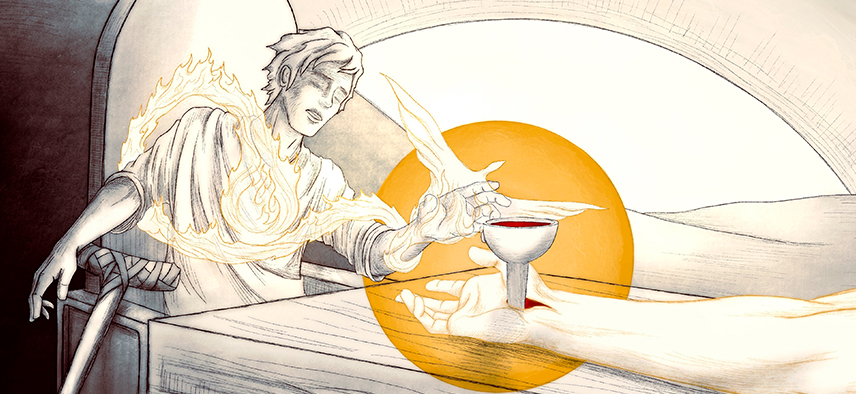Unlike most of the images I create for “Full of Eyes”, this one is more topical than exegenetic. I was invited to create an image that would join the themes of Mephiboseth invited to the king’s table (2Sm 9), as a Christian to the ?Sick soul invited to the feast of the Lord (Luke 14:12-24, especially v. 13), and to the dinner of the weddings of the Lamb, where the people of God healed and purified revel in the good food of all that God is to them in Christ (P 19:6-9). The aim was to unite all these images around the crucified and risen person of Jesus, in whom only our sickness is cured, our impurity is purified, as we sit at the feast table of God’s triune joy.
First, notice that the whole scene is illuminated by the light of what appears to be the rising sun and also the open tomb of the Risen Christ; Is it only in the light of Jesus’ resurrection that his life is delivered on the cross?real food and real drink from your people. The dark stone that was rolled over the tomb represents sin, death, suffering, sickness, and all that is overcome by Christ’s work on the cross.
- With this in mind.
- Then notice that the Christian is.
- As it were.
- Removed from the shadow of the stone so that he can receive communion with God in Christ.
- The crutch represents not only physical weakness and suffering.
- But also the deformity of our mind? Is it swallowed in the darkness of stone as it rolls before the light of Christ’s resurrection?.
Third, see that man came out of death to enter the life of Jesus risen by the work of the home of the Holy Spirit. The Spirit surrounds the Christian, sustains him, and gives him the strength to sit at the table, while also holding man’s hand in the life offered by Christ. Through the Spirit, we see and receive God in Christ (2Co 4. 6).
Fourth, look at the table itself, the table of communion with the God of the Trinity, it is the cross of Jesus Christ, it is here, on the cross of Christ, where the Son offers himself to the Father through the Spirit (Ey 9:14), that we may be united in God’s own life and joy (Ps 36:8; Jn 17. 22-23; Ap 21. 2-3) . And if we want to know God to live (Jn 17:3), then it is this table that we must come to, it must be in this meal that we must participate. We only feast on faith in the living God when we receive it as someone whose body has been crushed and whose blood has been shed on Calvary.
Based on this concept, you finally notice?Is it more important?That the feast to which Christ invites his people is ultimately himself. It is the abundance of the house of God from which mankind is satisfied (Ps 36:8); it is good in all the goods that salvation ensures (Salt 16:2); it is the feast of abundant food and good old wine, prepared for all peoples (Is 25:6-8); He is the Servant, the Husband, and the Wedding Dinner Banquet (Lk 12:37,22,16; Ap 19. 6-8); it is the glare of the glory of the Father, for whom eternity is illuminated (Apoc 21:22), and in him we see the beauty that permeates creation as the waters cover the sea (Hc 2:14).
Who would have guessed that when King David invited Mefiboset to his table, he represented the consumption of reality itself; the gathering operated by grace and bought by the blood of the weak and broken, for the joy of living with God, to revel in the fulness of all that God is to them in the Son of David crucified and risen, Jesus Christ. sanctified be his name!

